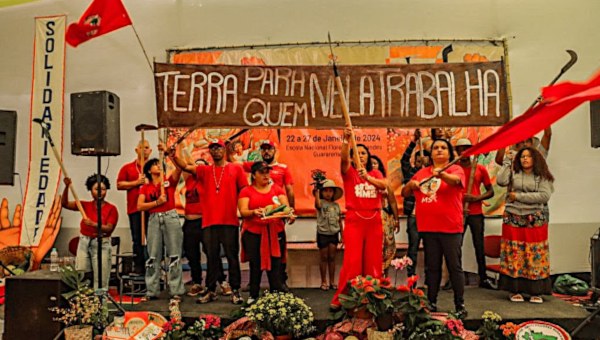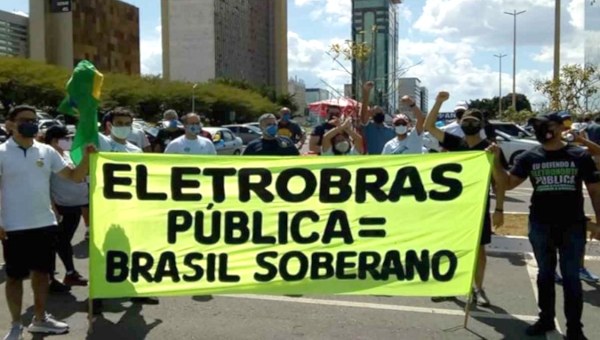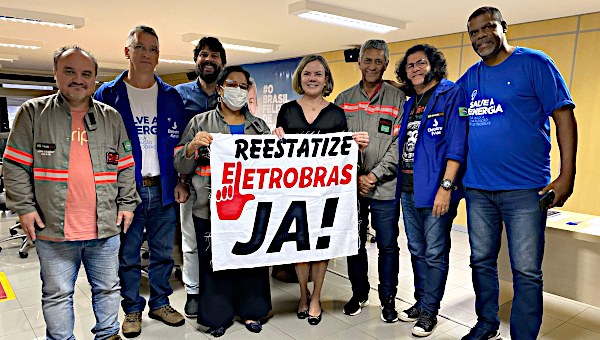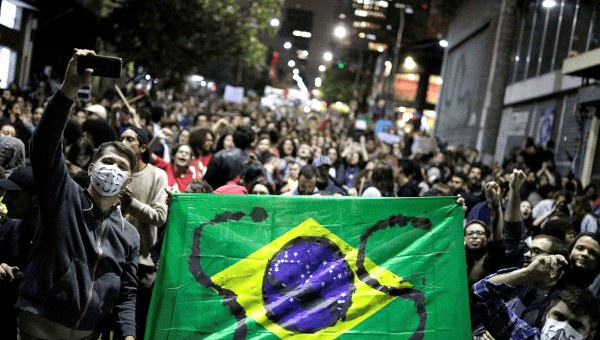After Lula’s Narrow Victory: Return to Democratic Capitalism or an Ongoing Rightwing Insurgency?
After a tough campaign, centrist candidate Lula da Silva of the Workers Party (PT) won the second and final round of the Brazilian presidential election on October 30 with 50.9 percent of the vote, 2.1 million votes more than his extreme-right adversary Jair Bolsonaro of the Liberal Party (PL).
This was the closest result for a Brazilian presidential election since 1989. Lula promised a return to democracy and normality in his victory speech on the packed Avenida Paulista in the center of São Paulo where tens of thousands assembled to celebrate. Bolsonaro remained silent for two days after the election, making only a very brief statement that made clear he would not contest the results.
Lula won 48 percent of votes in the first round against 43 percent for Bolsonaro. Astonishingly, Lula received 6.2 million more votes than Bolsonaro in the first round but won by only a small margin in the second. While 9.8 million Brazilians voted for candidates other than Lula or Bolsonaro in the first round, most of these votes went to Bolsonaro in the second.
Lula received 57.2 million votes in the first round, and 60.3 million in the second, mobilizing an additional 3.1 million votes. Bolsonaro scored 51 million votes in the first and 58.2 million votes in the second round, achieving an additional mobilization of 7.2 million voters, more than two-thirds of the votes that had gone to third candidates in the first round.
With this result, Bolsonaro received about 400,000 more votes than in 2018 when he won with more than 10 million votes ahead of his competitor Fernando Haddad of the PT. In 2022, the abstention in the second round was slightly lower than in the first round, adding another 500,000 votes to the total.
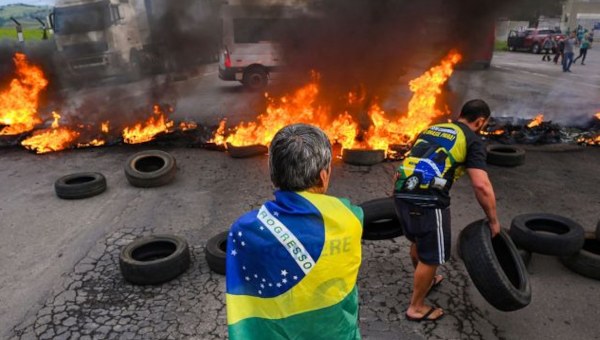
The Campaigns and the Coalitions
The election was fought tooth and nail, with the fake-news machinery of the Bolsonaro clan running at full speed. Although almost every day the electoral court ordered social media platforms and other vehicles to remove content, new fake news kept springing up quicker than the old could be banned and deleted. The electoral court also targeted some campaign material from Lula’s coalition that was deemed as abusive or factually incorrect.
Bolsonaro attempted to use the entire machinery of the state right up to the last moment in a bid to keep voters from exercising their right. The traffic police, who are very sympathetic to Bolsonaro’s followers, stopped more than 600 public buses transporting voters to polling stations, primarily in regions where Lula had done well in the first round. The electoral court learned of the plan the day before and banned all inspections by the traffic police on election day; nonetheless, the police set up roadblocks and intimidated voters with displays of heavy weapons.
Another form of election manipulation occurred with the more than 1000 cases in which employers tried to influence the vote of their workers. Two days before the election, one of Bolsonaro’s sons gave a speech in a slaughterhouse. Such actions by employers of holding election events, promising benefits for workers who vote for Bolsonaro or threatening workers with workplace closure, dismissals, or other negative consequences if they voted for Lula are illegal. This type of occurrence is not new as such, but its scale was unprecedented. Half of the efforts by employers to affect the vote took place in the state of Minas Gerais, which was heavily contested by the two candidates. It was obvious this was a well-organized strategy.
Bolsonaro’s campaign was negatively impacted in the final week by several events. A week before the election, an ally of Bolsonaro, veteran politician Roberto Jefferson fired 50 bullets and lobbed three grenades at police, wounding two of them. Jefferson was under house arrest at the time for involvement in anti-democratic activities such as the threatening of judges. He violated the terms of his house arrest in various ways, for example, by insulting Supreme Court justices on social media and hosting meetings with politicians.
He opened fire when police arrived to return him to jail, from which he had been released in January 2022 for health reasons. Police found more than 7000 bullets in his home. Bolsonaro tried to distance himself from Jefferson, but the effect in the media was not favourable. Bolsonaro himself publicly stated a few months prior that he would open fire if police attempted to arrest him.
Two days later Bolsonaro tried to divert attention from the Jefferson case by alleging that 16 radio stations in the Northeast did not air campaign ads produced by his team. The documentation brought forward by Bolsonaro in the case was weak, since it only encompassed data on online streaming which is not covered by legislation on electoral propaganda.
Bolsonaro tried to claim that the election would have to be postponed and that he would call for an emergency meeting with military commanders. It seems that military leaders did not take the case very seriously, and Bolsonaro’s communications manager apologized to the media three days later, admitting that the case made by Bolsonaro had been vastly exaggerated.
Worse still, on the day before the election, Carla Zambelli, a member of Parliament from Bolsonaro’s party, threatened a black man with a gun in the center of São Paulo after a political argument on the street. She claimed she had been physically attacked by a group of Lula supporters, but smartphone videos of the incident showed no such physical attack, only a verbal argument. Zambelli will face charges for the unlawful use of a gun.
The Lula campaign could count on a range of allies that spoke to different groups of voters, starting with the candidate for vice-president Geraldo Alckmin, a founding member of the liberal rightwing Social Democratic Party of Brazil (PSDB).
Simone Tebet, who finished third in the first round of elections, unexpectedly became a vocal participant in the second round on the side of Lula. She has a similar background to Alckmin’s, ran for the clientelist rightwing Democratic Movement of Brazil (MDB), and comes from a family of large landowners. She focused on excoriating Bolsonaro for his rampant misogyny.
Marina Silva, former Minister of Environment with Lula from 2003 to 2008, who fell out with him at the time due to his priority on industrial development over environmental concerns, also joined the campaign in a very active manner.
Another wild card in the campaign was André Janones, like Marina Silva, a former member of the PT. He ran for president for the small Avante Party but dropped out of the race early and became a social media advisor and influencer for Lula’s campaign, characterized by a more aggressive style than Lula himself would adopt for the campaign.
With this multifaceted approach, Lula’s campaign adopted, to some extent, the tactics of Bolsonaro’s team on social media. Bolsonaro tailored his messages to different voter groups, adjusting his style and rhetoric accordingly.
Detailed Results
The elections for federal governors also went into the second round in 12 states. Of these, Bolsonaro’s allies won the largest number, five. The state of São Paulo, which had never been won by a leftwing candidate, flipped from a center-right governor to the extreme-right politician Tarcisio de Freitas from the Republican Party. De Freitas served as Minister of Infrastructure under Bolsonaro, yet is more pragmatic and less ideological than others of his kind.
The states of Santa Catarina, Amazonas, Mato Grosso do Sul, and Rondonia went to candidates allied with Bolsonaro. In the last two of these states, both candidates in the second round were allies of Bolsonaro.
The center-right won four states: Rio Grande do Sul, Alagoas, Pernambuco, and Sergipe. Here the success of Eduardo Leite of the PSDB in Rio Grande do Sul was a surprise. He finished second in the first round against Onyx Lorenzoni, who served in various posts in the Bolsonaro government. Lorenzoni systemically attacked Leite with homophobic insults during the campaign.
Apart from Simone Tebet, Leite is one the few hopefuls for the refoundation of the center-right, which has been almost wiped out by Bolsonaro’s dominance on the right wing of Brazil’s political spectrum since 2018.
The left won three states in the second round: the industrial center Espirito Santo and the Northeastern states of Paraiba and Bahia – Bahia is the fourth largest Brazilian state in terms of population.
Taken together with the first round of the election, of the 27 federal units of Brazil, 13 will be governed by allies of Bolsonaro, seven by the center-right and seven by the left. Yet, the borders between the center-right and Bolsonarismo are porous, and we can expect some movement between themin the coming months. It is likely some governors will shift to the center-right, given that Bolsonaro lost the presidency.
Nevertheless, the results show, in addition to the close results of the presidential contest, that the ideas associated with Bolsonarismo have traction. It is politically significant that candidates with a close connection to Bolsonaro will govern the three most populous states of São Paulo, Rio de Janeiro, and Minas Gerais.
Some crucial insights into voter preferences were revealed in polls conducted immediately before the elections by Datafolha, which predicted Lula would win with 52 percent. The only income groups where Lula has a majority, according to the poll, are the poorest sections of society who earn up to two times the minimum wage, about US$400/month. In all other income groups, Bolsonaro led the race.
It is interesting to note in which federal states Lula scored better than Fernando Haddad, the PT candidate who ran against Bolsonaro in 2018. Although the populous states of São Paulo and Rio de Janeiro were won by Bolsonaro this time and in 2018, Lula improved upon Haddad’s results from 2018 by 12.7 percent in São Paulo state and 11.4 percent in Rio de Janeiro.
Lula also bested Haddad’s results in other Bolsonaro strongholds like Minas Gerais, Mato Grosso do Sul, Paraná, Goias, Santa Catarina, and Rio Grande do Sul – here Lula did between six and eight percentage points better than Haddad in 2018. This reveals an increase of support for Lula in regions that are vote-rich bastions for Bolsonaro.
In the Northeast, Lula’s stronghold in the first and second round of elections, the results were quite similar to those in 2018 for Haddad. While it is often claimed in the media that the Northeast was key for winning the election, it was the mobilization of additional voters in the Southeast of Brazil that secured victory for Lula. He won the election both in the city of São Paulo and its metropolitan region, but not in the broader regions of this most populous state, which almost exclusively were claimed by Bolsonaro.
Perspectives and Challenges
There are two central questions regarding the prospects for the third Lula presidency. Will there be an ongoing insurgency by the right against the Lula government? And, what will be the room for maneuver for progressive politics in face of the conservative composition of Parliament and the Senate? Most governors who are close to Bolsonaro have already signaled they are ready to cooperate with Lula.
Nevertheless, on the evening of the election, a motley crew of Bolsonaro supporters – a mix of truck drivers, the petty-bourgeoisie and other elements – questioned the election results, proceeded to set up roadblocks, and demanded military intervention. The traffic police, which, as mentioned, was very effective in stopping some voters from heading to the polls on election day, reacted slowly to Bolsonaro’s militant supporters and at times even maintained the roadblocks.
This movement reached its peak on the morning of November 1, with 271 road blockages, of which 167 remained active the next morning. By November 4, the roadblocks had almost disappeared. Many governors aligned with Bolsonaro, such as Claudio Castro in Rio de Janeiro, deployed the military police to dismantle the roadblocks.
Ironically, because the roadblocks were most prevalent in regions where Bolsonaro’s support was strongest, as in Mato Grosso and Santa Catarina, his voters were the ones primarily affected. After just one day supermarkets reported their stocks were down by 70 percent, and many regions endured shortages of petrol. In some cases, organized football fans, people from poor neighbourhoods, and shipyard workers confronted the rightwing insurgents and removed the roadblocks.
Overall, these protesters had little support from the public at large, apart from a few radicals close to Bolsonaro. Bolsonaro himself made a positive reference to the protests in his mini-speech on November 1 but said rightwing protesters should not imitate the movements of the left and should keep freedom-of-movement intact – just as Bolsonaro had defended against calls for lockdowns and restrictions during the pandemic.
Rightwing Opposition to Lula’s Programme
There is concern among leftists that such militant rightwing movements will exercise pressure on the Lula government. For such movements to persist, a lot depends on whether they will be able to find and maintain organic leaders. Bolsonaro himself seems more concerned with staying out of jail, hence his eagerness to meet with the Supreme Court justices after his electoral defeat. His intention is most likely to negotiate a cessation of the 36 criminal investigations targeting him that will go ahead once he steps down as president.
The general assumption is that he will offer not to rally on behalf of an insurgent movement against President-elect Lula, in exchange for being spared jail time. While it is unlikely that the Supreme Court will concede to such a trading of favours, such an offer would demonstrate that a future as a political leader might not be Bolonaro’s first priority. His first speech after the election seemed to be more of an obligation, and he clearly did not use the opportunity to motivate his militant supporters.
A more serious challenge for Lula will be the opposition in Congress and the Senate. The vested interests of agribusiness and the evangelical churches and the organized interests of capital in general might block legislative initiatives that benefit the bulk of Brazilians. The areas where urgent new policies are expected are numerous. Among the most pressing problems are those of widespread hunger, lack of running water, sanitation, and waste disposal. Only half of Brazilians are connected to a sanitation system and are adversely affected by the attendant massive environmental and health problems among the poorer populations that such a situation produces.
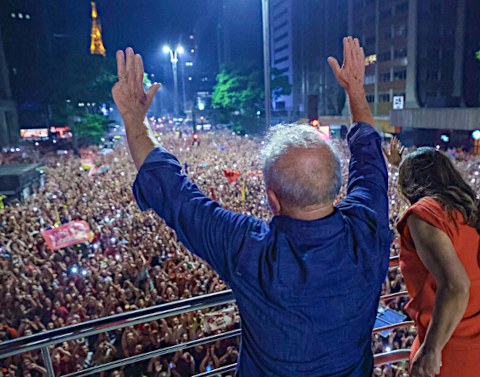
Other areas of necessary action include public transport and the health and education systems, all underfunded and poorly organized. It will be hard to convince elites to transfer financial resources to areas that benefit the poor majority, as the selective distribution of resources in Brazil is also a means of reproducing relationships of political domination.
Initiatives to contain illegal gold mining and deforestation will also require a transfer of wealth from elites, and the environmental protection agencies that have been dismantled and underfunded by the Bolsonaro government will have to be rebuilt. Lula announced he will create a ministry for Indigenous people that will add new resources for the protection of territories belonging to traditional communities and peoples.
Another huge challenge will be employment law. Reform in 2017 by the government of Michel Temer led to massive wage cuts and an increase in informal employment. Lula promised a new labour code to replace the traditional labour code, the CLT (Consolidação das Leis do Trabalho), which goes back to Getulio Vargas’s corporatist efforts in 1943.
The CLT is in many ways inflexible and inhibits the integration of many workers into the formal sector. On the other hand, it will be a huge task to create a wholly new body of law that would replace the existing labour code. The minimum that can be expected is a legal regulation of app-based gig work.
In all these policy areas the Lula government will have to negotiate with Congress and the Senate, the latter of which has a high number of Bolsonaro hardliners who will obstruct any initiatives. One essential question is to what extent the Lula government will be able to convince parts of the bourgeoisie to support initiatives that could benefit their business interests and the bulk of the population. Much will depend not solely on economic interests but on the political conjuncture and the extent to which the rightwing will be able to project itself as a viable alternative.
The geopolitical level might be an area where the Lula government has more room to maneuver. Foreign policy has been one of Lula’s strong areas and can be expected to continue to be so with his new presidential term. There will be an attempt at some revival of the, more or less, dead project of the BRICS bloc, which is now hampered by Russia’s invasion of Ukraine. Lula gave signals that he wants to undertake initiatives to end the war.
Other difficulties for the BRICS bloc include the authoritarian turn in China and the extreme-right presidency of Modi in India, which has become much more repressive in its second term. Lula will, in any case, promote a third bloc beyond NATO and Russia.
More fertile terrain for these geopolitical ambitions can be found in Latin America, where several governments of the left in Chile, Colombia, Argentina, Mexico, Bolivia, Venezuela, and Cuba will be partners for the Lula government. Argentine president Alberto Fernandez visited Brazil the day after the election. The stalled negotiations for a Mercosur-EU free-trade agreement will also be revived, but Lula has made clear he wants to renegotiate the treaty with a stronger focus on the export of industrial products from Brazil to the EU. •


